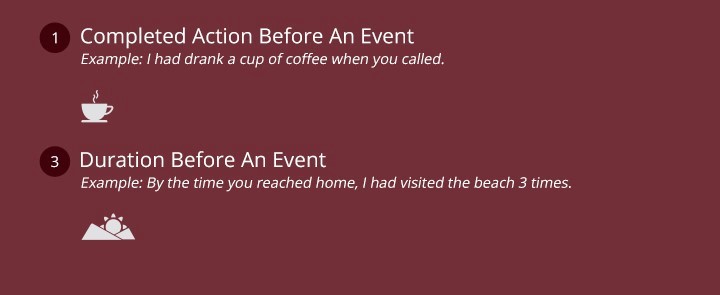Past Perfect Tense is one of the four sub-division of Past Tense. Past perfect tense refer to those actions which were carried out in the past and were completed at the same time.

It can be understood more clearly with the help of the following given structures with examples.
1. Sub + had + v3 + obj. (Affirmative i.e. Positive Sentences)
- She had cooked food.
- He had played basketball.
2. Sub + had + not + v3 + obj. (Negative sentences)
- She had not cooked food.
- He had not played basketball.
3. Had + sub + v3 + obj? (Positive Interrogative)
- Had she cooked food?
- Has he played basketball?
4. Had + sub + not + v3 + obj? (Negative Interrogative)
- Had she not cooked food?
- Had he not played basketball?
5. Wh-word + had + sub + v3 + obj? (Wh-question)
- What had she cooked?
- What he played?
Where Past Perfect Tense is used?

Past Perfect Tense is used for actions or events which completed before a certain time in the past. We should understand that in the Past Perfect Tense all the actions should have completed in the past itself.
- The child had played with the toys.
- They had done their homework.
- He had met his parents five years before.
- The patient had fainted before she was injected.
- I had met my grandmother before she went to Bhutan.
Past Perfect Tense is used with had + v3 + before + v2. The word ‘before’ plays a vital role here as the actions in the past occur before other successive events take place.
- He had eaten before she fought.
- They had smoked before the teacher arrived.
- They had beaten him before the police arrived.
- She had married him before her parents came.
- We had finished cooking before guests arrived.
Past Perfect Tense used with V2 + after + had + v3. The word ‘after’ plays vital roles here as events/actions occur in a consecutive manner and the later part uses this structure.
- She cried after her love of life deserted her.
- She fought after he had eaten.
- The teacher arrived after they had smoked.
- The police arrived after they had beaten him.
- The guests arrived after we had finished cooking.
Past Perfect Tense is used with the prior/first action among the two actions which occurred in the past.
- The boy had fainted before his mother came.
- The kidnapper had fled before the police arrived.
- It had started raining before I reached home.
- My husband had already boarded his flight when I reached airport.
- They had started the game before their coach arrived.